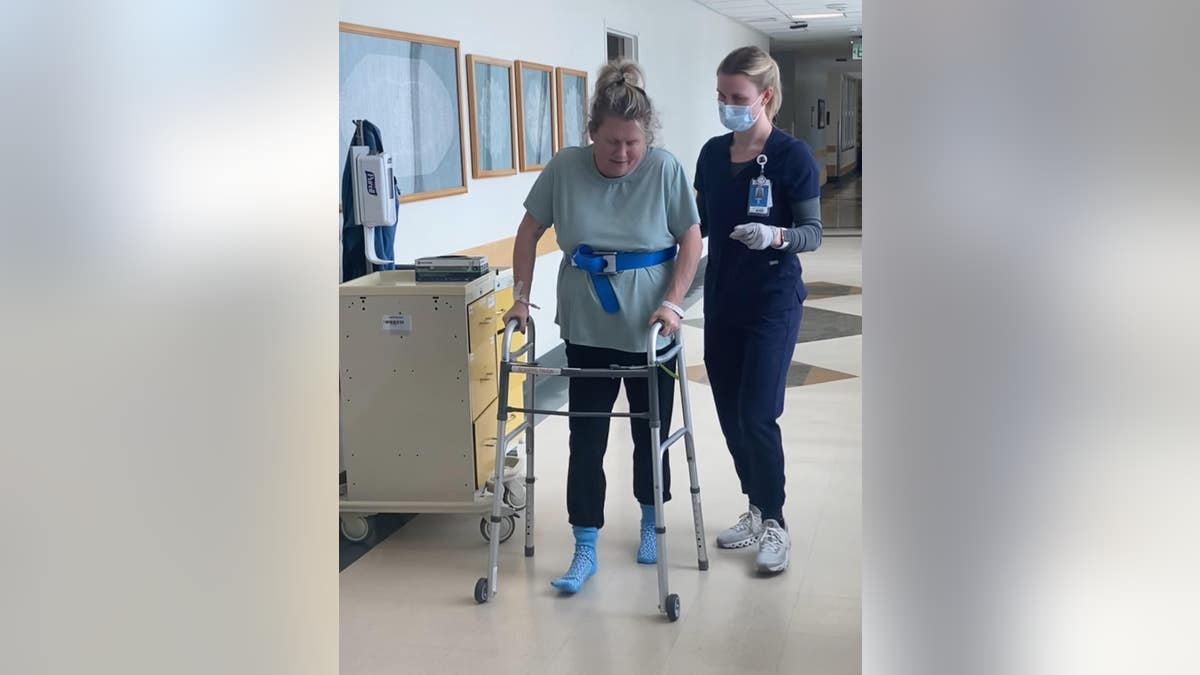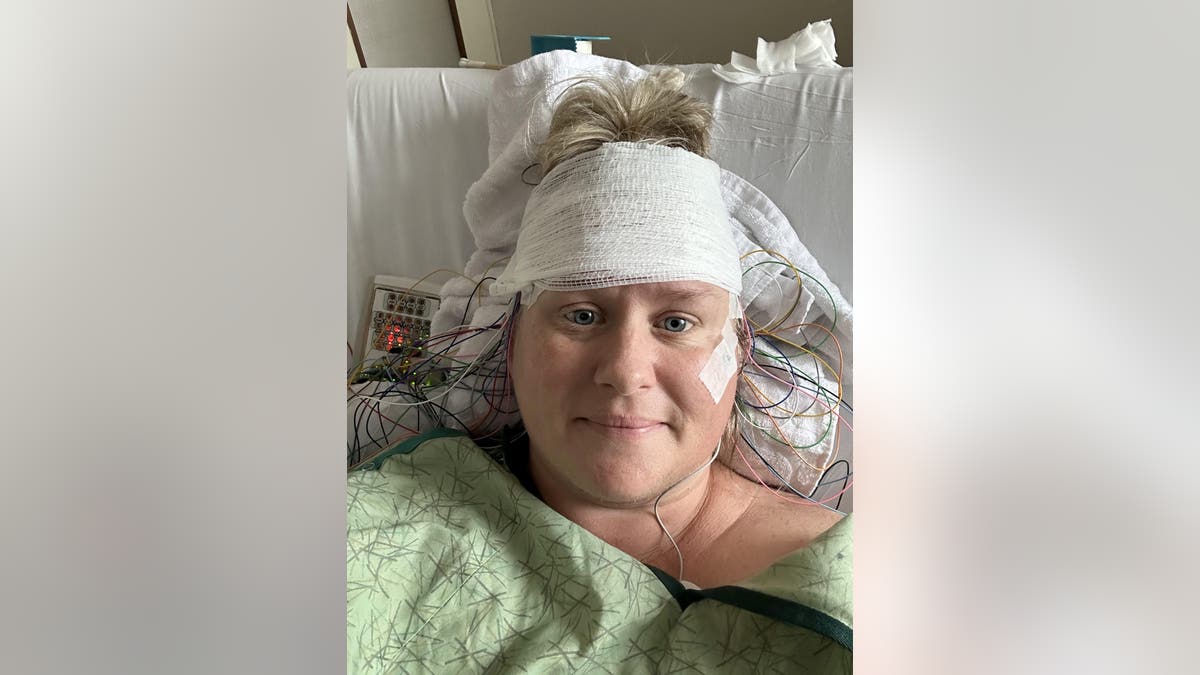This story discusses suicide. If you or someone you know is having thoughts of suicide, please contact the Suicide & Crisis Lifeline at 988 or 1-800-273-TALK (8255).
A little-known neurological disorder has been thrust into the spotlight after a documentary revealed singer Celine Dion’s struggle with stiff person syndrome (SPS).
The disease is rare, affecting only one or two people for every million. Yet for those who are diagnosed, it can have a devastating impact, causing muscle rigidity, pain and spasms.
LIKE CELINE DION, PENNSYLVANIA MAN IS FIGHTING STIFF PERSON SYNDROM WITH ‘EVERYTHING I HAVE’
Two people who are living with stiff person syndrome — Carrie Robinette, 45, from San Diego, California, and Corwyn Wilkey, 44, who lives in Anchorage, Alaska — shared with Fox News Digital the details of their experience.
Path to diagnosis
Robinette, a Navy wife and mother who was working as a full-time defense consultant, had been dealing with multiple health issues — pain, neuropathy, fatigue, migraines, asthma, allergies, thyroid and endocrine issues, kidney issues, even cancer — for more than 15 years.
“I was honestly ‘always sick’ from the time I was born,” she said in a phone interview with Fox News Digital.
“Also, even as far back as high school, I had incredibly tight muscles in my legs, and there were countless times that I woke up crying with charley horse cramps in my calves.”
Then, in May 2023, Robinette began experiencing painful, full-body spasms.
LUPUS EXPERT DEBUNKS 7 COMMON MYTHS ABOUT THE AUTOIMMUNE DISEASE: ‘NOT A DEATH SENTENCE’
That kicked off a year of testing and visits to specialists in rheumatology, nephrology, endocrinology and neurology.
“After learning more and going back through my medical history, we realized that symptoms we previously blamed on other causes were likely early signs of stiff person syndrome.”
Over the last year, as Robinette’s “constellation of symptoms” intensified, the doctors finally narrowed it down.
“It is beyond frustrating to literally not know at the start of each day if it will be a good day or a bad day.”
“There is not a consensus within the SPS community on exact diagnostic criteria, and some doctors seem hesitant to diagnose rare diseases, so the journey to diagnosis is complicated by how rare the illness is,” Robinette said.
“Definitive testing is not readily available.”

These days, Robinette’s biggest challenge is frequent pain.
“Even if my body is not actively spasming, it feels like my muscles are sore, even bruised — all day, every day,” she said. “I think eventually, we grow accustomed to our pain, so it just becomes the new normal.”
Some days, Robinette can walk and move “almost like normal,” while other days she can’t walk without a cane or walker.
THE GIRL WHO CAN’T SMILE: HOW A RARE DISORDER BECAME A YOUNG WOMAN’S ‘GREATEST GIFT’
She regularly uses a mobility chair when traveling any distance beyond 50 feet.
“It is beyond frustrating to literally not know at the start of each day if it will be a good day or a bad day.”
‘Initial symptoms’
Wilkey, a father of young children who works as an interpretive media publications specialist for Alaska State Park and is also a singer, first noticed muscle spasms in his larynx while performing with his band.

“Like Celine Dion, my initial symptoms were throat and facial spasms that have progressed into full-body seizures,” he told Fox News Digital via email.
Wilkey was officially diagnosed with stiff person syndrome in 2021 at the Mayo Clinic in Rochester, Minnesota.
PENNSYLVANIA MOM SEEKS ‘PERFECT MATCH’ BONE MARROW DONOR TO CURE DAUGHTER’S RARE DISORDER: ‘CRUCIAL NEED’
“The most prominent physical challenges are muscle stiffness and rigidity, seizure-like muscle spasms, cognitive distortion and decline, chronic pain and fatigue, PTSD, loss of coordination and fine motor control, headaches, joint pain, back pain, and inability to coordinate my body the way I want to,” he said.
Wilkey’s full-body spasms are sometimes strong enough to dislocate and even fracture bones, he said.
James Chung, M.D., PhD, chief medical officer at Kyverna Therapeutics in Emeryville, California, noted that diagnosis of stiff person syndrome is a complex process. (He has not treated either of the patients mentioned in this article.)

“We start with a detailed clinical evaluation, looking for characteristic muscle rigidity and spasms,” Chung, who focuses on drug development for autoimmune diseases, told Fox News Digital via email.
FDA APPROVES NEW DRUG TO TREAT AUTOIMMUNE LIVER DISEASE: ‘GIANT STEP FORWARD’
Blood tests are also needed to detect the antibodies that are found in a majority of cases, he said.
“Given the rarity of SPS, patients often feel misunderstood, even by health care professionals.”
“Electromyography (EMG) is essential, showing continuous motor unit activity in affected muscles,” he said.
In many cases, doctors will perform a lumbar puncture (spinal tap) to analyze cerebrospinal fluid for elevated antibodies and to rule out other conditions, along with imaging scans.
“SPS is often a diagnosis of exclusion due to its rarity,” Chung said.
Limited treatments
While there is currently no cure for stiff person syndrome, therapies can help manage symptoms and improve patients’ quality of life.
Treatments are highly personalized for each patient, according to Chung.

In most cases, patients take medications like diazepam and baclofen to reduce muscle stiffness and spasms, and may take intravenous immunotherapies to help reduce autoantibodies.
“Pain management often involves a combination of medications,” Chung said. “Physical and occupational therapy are vital.”
Some current medications can have intense side effects, however.
RARE CONDITION CAUSED PATIENT TO SEE ‘DEMONIC’ FACES, SAYS STUDY ON ‘VISUAL DISORDER’
Robinette has experienced hallucinations, loss of muscle control, nausea, vomiting and brain fog.
“For now, unfortunately, I am currently battling my condition without any helpful medications, and it is nearly unbearable,” she said.
Kyverna Therapeutics is currently developing a new CAR-T cell therapy, KYV-101, that aims to “reset” the immune systems of patients with autoimmune diseases, according to Chung.

“This approach could potentially offer a more targeted treatment that addresses the root cause of SPS rather than just managing symptoms,” he said.
The drug has recently gotten FDA approval to enter phase 2 clinical trials.
“I can really see it being the life-changing treatment that so many people with SPS and other autoimmune conditions need,” said Robinette. “I just wish science moved faster!”
Mental and emotional effects
Many patients with stiff person syndrome struggle with anxiety about experiencing spasms in public, which often leads to social isolation, according to Chung.
“Depression is common, stemming from chronic pain, loss of independence and the disease’s unpredictable nature,” he told Fox News Digital.
NEW JERSEY TWINS RECEIVE MATCHING HEART SURGERIES AFTER MARFAN SYNDROME DIAGNOSIS: ‘A BETTER LIFE’
“Patients also frequently experience frustration with the medical system due to misdiagnosis or dismissal of symptoms,” he added.
“Given the rarity of SPS, patients often feel misunderstood, even by health care professionals.”
When Wilkey received his diagnosis, he struggled with treatment-resistant depression, PTSD and complex regional pain syndrome, he told Fox News Digital.

“The difficulties associated with the disease destroyed my marriage and, for a time, turned me into a rage monster,” he said.
“It has felt very much like receiving a death sentence.”
To treat his “incredible” pain, Wilkey was prescribed oxycodone and morphine, which ultimately led to addiction.
OHIO BOY, 8, PREPARES FOR BLINDNESS: ‘IT’S HEARTBREAKING,’ HIS MOM SAYS
“I became unable to function and felt like a burden on my family, which led me to attempt suicide,” he said.
Wilkey underwent a period of hospitalization, intensive therapy and pain rehabilitation programs.
“I lost everything — my marriage, all my money, my home and even my children for a time,” he said.

Today, Wilkey continues to participate in palliative care therapy — as SPS is considered a progressive and terminal disease — as well as psychedelic-assisted therapy for PTSD and depression.
Robinette has also experienced mental and emotional challenges stemming from her disease.
“This past year, on my journey with SPS, my family and I have really been put through the wringer,” she told Fox News Digital.
“It takes a toll to feel like you are in a medical crisis and yet know that even if you go to the hospital, no one will help you.”
“Seizing, in 10 out of 10 pain, losing control of muscles, and having the body twist and contort into a terrifying, seemingly endless episode — some of these events last 10 to 60 minutes, which feels like an eternity.”
The hardest part, she said, is that some doctors have told her, “It could be in your head,” or “We can’t help you because we aren’t sure what it is.”
“It takes a toll to feel like you are in a medical crisis and yet know that even if you go to the hospital, no one will help you,” Robinette said.

“I think it would make a world of difference to SPS patients to not have the added stress of having to constantly have to advocate for care.”
Stress management is crucial for SPS patients, Chung said, as emotional stress can trigger or worsen spasms.
“Supporting mental health is a key component of comprehensive SPS care.”
Who is most at risk?
Stiff person syndrome is a progressive and ultimately terminal neuromuscular autoimmune disease.
SPS shows certain demographic patterns, Chung said.
“It is incredibly empowering to know that you are not alone.”
“Women are more commonly affected, with a 2:1 ratio compared to men,” he said.
The typical age of diagnosis is between 30 and 60 years of age.
“There’s a strong association with other autoimmune disorders,” Chung said, which can complicate the diagnosis process.
“About 30% to 40% of SPS patients have type 1 diabetes, and we see higher rates of thyroiditis, vitiligo and pernicious anemia,” the doctor went on.
“This clustering suggests a genetic predisposition to autoimmunity, although we haven’t identified specific genes for SPS.”
Advice for handling a diagnosis
For those who are living with stiff person syndrome, Chung said the best course of action is to get education from reliable sources and to build a strong support network.
“Work closely with a multidisciplinary medical team, be proactive in your treatment and communicate openly with your health care providers,” he advised.
CLICK HERE TO SIGN UP FOR OUR HEALTH NEWSLETTER
The doctor also recommended practicing stress-reduction techniques and staying as physically active as safely possible under professional guidance.

Wilkey’s best advice: “Don’t try and go it alone.”
He said, “You will drive yourself insane and beat your head against the wall, trying to cope on your own. Connecting with other survivors and developing a solid support system of crucial allies is essential.”
For Robinette, sharing her story has been a helpful coping mechanism.
“It is incredibly empowering to know that you are not alone,” she said.
For more Health articles, visit www.foxnews/health
“I believe that the more our voices rise, the more chance we all have of being heard.”
Those seeking more information and resources for stiff person syndrome can visit The Stiff Person Syndrome Research Foundation at www.stiffperson.org.
Read the full article here











